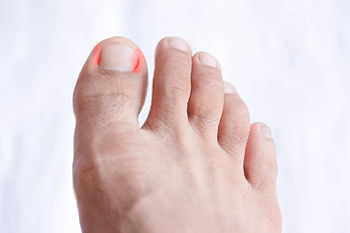
Ingrown toenails occur when the nail grows into the skin surrounding it. While they generally occur on the big toe, they can affect any toe. One common cause of ingrown toenails is the shape of the nail. This can be hereditary. Nails that become more broad at the top of the toes or nails that are naturally curly have a tendency to push into the skin. Trauma to the toenail or wearing shoes that are too tight can also lead to ingrown toenails. Signs of an ingrown toenail include redness around the side of the toe near the nail, swelling of the toe, and liquid seeping from the side of the nail. Because ingrown toenails are prone to infection, it is important to visit a podiatrist especially if an ingrown toenail persists.
Ingrown toenails can become painful if they are not treated properly. For more information about ingrown toenails, contact Richard P. Jacoby, DPM of Phoenix Foot Care Network. Our doctor can provide the care you need to keep you pain-free and on your feet.
Ingrown Toenails
Ingrown toenails occur when a toenail grows sideways into the bed of the nail, causing pain, swelling, and possibly infection.
Causes:
Prevention
Because ingrown toenails are not something found outside of shoe-wearing cultures, going barefoot as often as possible will decrease the likeliness of developing ingrown toenails. Wearing proper fitting shoes and using proper cutting techniques will also help decrease your risk of developing ingrown toenails.
Treatment
Ingrown toenails are a very treatable foot condition. In minor cases, soaking the affected area in salt or antibacterial soaps will not only help with the ingrown nail itself, but also help prevent any infections from occurring. In more severe cases, surgery is an option. In either case, speaking to your podiatrist about this condition will help you get a better understanding of specific treatment options that are right for you.
If you have any questions please feel free to contact one of our offices located in Scottsdale and Peoria, AZ. We offer the newest diagnostic and treatment technologies for all your foot and ankle needs.
Read more about Ingrown Toenails